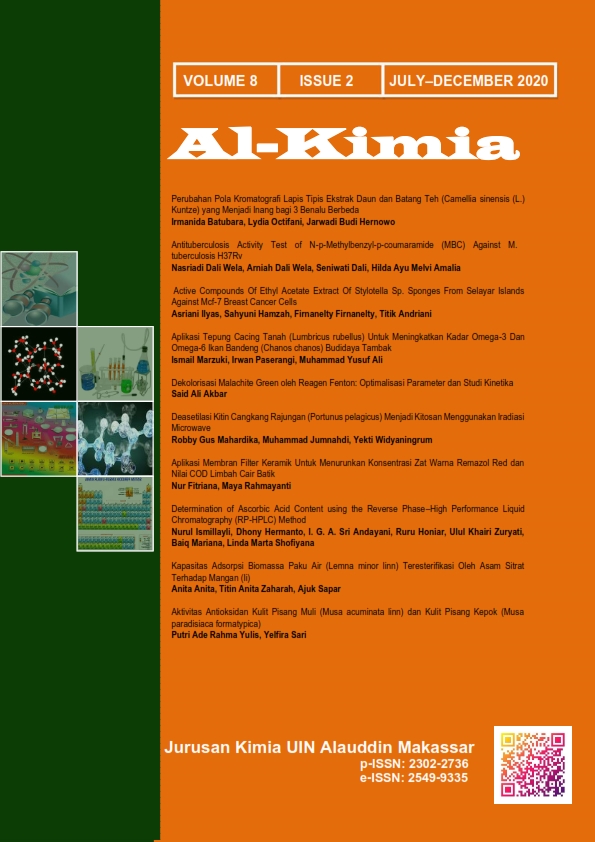Dekolorisasi Malachite Green oleh Reagen Fenton: Optimalisasi Parameter dan Studi Kinetika
Abstract
The study of the decolorization of Malachite Green in solution using the Fenton reagent has been investigated. The effects of different reaction parameters such as hydrogen peroxide concentration, iron ion concentration, pH of the solution, and initial dye concentration have been carried out. In this study the experimental range for H2O2 concentrations varied from 0.2 mM to 4 mM and Fe2+ ions were 0.01-0.1 mM. All experiments were carried out at room temperature of 27 oC. Furthermore, the optimal oxidation condition with the concentration of MG dyes of 20 mg/L was with H2O2 0.5 mM, Fe2+ 0.05 mM, and pH at 3. The dye decolorization process of MG was also observed kinetically, it was found that the degradation process took place with first-order reaction rate. Under optimal conditions, the dye solution with a concentration of 20 mg/L completely decolorized within 60 minutes at 27ºC, and 76% of the Chemical Oxygen Demand (COD) was removed. This proves that MG was not only decolorized but also mineralized.
Downloads
References
Boonrattanakij, N., Sakul, W., Segura, S.G., Lu, M.C. (2018). Implementation of fluidized-bed Fenton as pre-treatment to reduce chemical oxygen demand of wastewater from screw manufacture: Influence of reagents feeding mode, Separation and Purification Technology, 20231, 275-280.
Choudhary, M., Kumar, R., & Neogi, S. (2020). Activated biochar derived from Opuntia ficus-indica for the efficient adsorption of malachite green dye, Cu2+ and Ni2+ from water, Journal of Hazardous Materials, 39215, 122441.
Faye, M.C.A.S., Zhang, K.K., Peng, S., & Zhang, Y. (2019). Sludge dewaterability by dual conditioning using Fenton’s reagent with Moringa oleifera, Journal of Environmental Chemical Engineering, 7(1), 102838.
Gavrilenko, N.A., Volgina, T.N., Pugachev, E.V., & Mikhail A. Gavrilenko, M.A. (2019). Visual determination of malachite green in sea fish samples, Food Chemistry, 27415, 242-245.
Guo, Q., Li, G., Liu, D., & Wei, Y. (2010). Synthesis of zeolite Y promoted by Fenton's reagent and its application in photo-Fenton-like oxidation of phenol, Solid State Sciences, 91, 89-95.
Iskander, S.M., Novak, J.T., & He, Z. (2019). Reduction of reagent requirements and sludge generation in Fenton's oxidation of landfill leachate by synergistically incorporating forward osmosis and humic acid recovery, Water Research, 15115, 310-317.
Jurczyk, Ł., & Jurczyk, J.K. (2017). Quantitative dynamics of ammonia-oxidizers during biological stabilization of municipal landfill leachate pretreated by Fenton’s reagent at neutral pH, Waste Management, 63, 310-326.
Kubo, D., & Kawase, Y. (2018). Hydroxyl radical generation in electro-Fenton process with in situ electro-chemical production of Fenton reagents by gas-diffusion-electrode cathode and sacrificial iron anode, Journal of Cleaner Production, 2031, 685-695.
Lamb, J.J., Islam, M.H., Hjelme, D.R., Pollet, B.G., & Lien, K.M. (2019). Effect of power ultrasound and Fenton reagents on the biomethane potential from steam-exploded birchwood, Ultrasonics Sonochemistry, 58, 104675.
Lien, H., Yu, C., Kamali, S., & Sahu, R.S. (2019). Bimetallic Fe/Al system: An all-in-one solid-phase Fenton reagent for generation of hydroxyl radicals under oxic conditions, Science of The Total Environment, 67310, 480-488.
Qin, J., Li, Y, Feng, M., Li, H., & Lin, C. (2017). Fenton reagent reduces the level of arsenic in paddy rice grain, Geoderma, 3071, 73-80.
Salamat, S., Hadavifar, M., & Rezaei, H. (2019).Preparation of nanochitosan-STP from shrimp shell and its application in removing of malachite green from aqueous solutions, Journal of Environmental Chemical Engineering, 7(5), 103328.
Shanmugam, B.K., Easwaran, S.N., Mohanakrishnan, A.S., Kalyanaraman, C., & Mahadevan, S. (2019).Biodegradation of tannery dye effluent using Fenton's reagent and bacterial consortium: A biocalorimetric investigation, Journal of Environmental Management, 24215, 106-113
Wang, Y., Hung, I., & Wu, C. (2018). The characteristics and electrochemical performance of graphite felts with thermal and fenton's reagent treatment for vanadium redox flow battery, Ceramics International, 44, s30-s33.
Wang, Y., Wang, Z., Pan, J., & Liu, Y. (2019). Removal of gaseous hydrogen sulfide using Fenton reagent in a spraying reactor, Fuel, 2391, 70-75.
Wu, H., Chen, H., Wang, Q., & Yang, H. (2019). Characteristics and inhibition of mercury re-emission from desulfurization slurry by Fenton reagent, Fuel Processing Technology, 1881, 89-97.
Yamaguchi, R., Kurosu, S., Suzuki, M., & Kawase, Y. (2018). Hydroxyl radical generation by zero-valent iron/Cu (ZVI/Cu) bimetallic catalyst in wastewater treatment: Heterogeneous Fenton/Fenton-like reactions by Fenton reagents formed in-situ under oxic conditions, Chemical Engineering Journal, 33415, 1537-1549.
Authors who publish with this journal agree to the following terms:
1) Authors retain copyright and grant the journal right of first publication with the work simultaneously licensed under a Creative Commons Attribution License that allows others to share the work with an acknowledgement of the work's authorship and initial publication in this journal.
2) Authors are able to enter into separate, additional contractual arrangements for the non-exclusive distribution of the journal's published version of the work (e.g., post it to an institutional repository or publish it in a book), with an acknowledgement of its initial publication in this journal.
3)Authors are permitted and encouraged to post their work online (e.g., in institutional repositories or on their website) prior to and during the submission process, as it can lead to productive exchanges, as well as earlier and greater citation of published work (See The Effect of Open Access).


